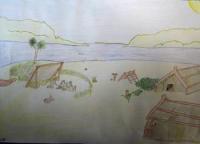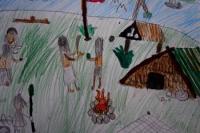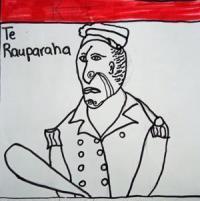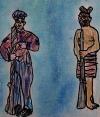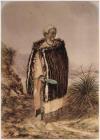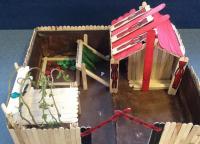First footsteps
Who made the first footsteps?
Some of the first footsteps were made by Kupe, one of the great Polynesian explorers. Kupe arrived in New Zealand in 925 A.D. When Kupe and other explorers found New Zealand, it was very different from their tropical island homes. New Zealand was much bigger and much colder, with some strange plants, birds and fish. They had to find some new materials to make their huts. They found some flax and raupō (bulrush) and those were very good for weaving. Soon they got all that they wanted and started making their huts.
In Room 15 we’re only using toitoi, flax and raupō to make some manu tukutuku with our teacher, Rachel.
The Ngāti Toa had lived for centuries around the shore of Kawhia Harbour. The founding ancestor of their tribe was Ngāti Toarangatira. Ngāti Toarangatira was descended from the captain of Tainui canoe Hoturoa. The people of the land were the first Māori settlers who arrived in the densely-forested Porirua basin over 600 years ago. The region was inhabited only by birds (such as the moa, kiwi and penguin) and a wide range of insects (including the giant weta). What do we know about these early Porirua settlers? We know that Māori traditions were passed down orally for hundreds of years, which tells us something of the first explorers and the various tribes that have occupied Porirua. Kupe, the legendary discoverer of Aotearoa, is associated with several parts of the Porirua region. Kupe is believed to have discovered Mana Island which he named Te Mana o Kupe ki Aotearoa.
Māori Settlers and European Settlers
Over 600 years ago the Māori settlers came and then the European settlers came and they bought the land. The Māori thought if you sold the land, you still owned it as you were only letting people use it by paying for it. However, the European settlers thought they owned it as they had paid for it. This led to them having a big fight. Today there is a clearer understanding about the meaning of selling land. It would have been nice if they did not have a fight about the land.
Te Rauparaha
Te Rauparaha was a war chief for the tribe Ngāti Toa. He was a very clever and cunning man in a fight as he was a very strong and powerful chief. Te Rauparaha was born in 1768 at Maungatautari near Cambridge and died on the 27th of November 1879 in Ōtaki, aged 81. Over his time, he had 8 wives and 14 children. Te Rauparaha got his name from an edible plant named Rauparaha shortly after his birth. He had six toes on one foot and so did his son. Some of his descendants also have this.
Te Rauparaha brought his tribe down to Porirua from Kawhia in the 1820s. This transition took about 2 years. In that time they crossed rival and unknown tribal land and even friendly land just to get to the beautiful and marvellous place of Porirua. However it wasn’t all nice and easy going. They had to fight a tribe on Kāpiti Island to take over Porirua. The odds were slim it was 200 to 1,000. Imagine that! In the end Ngāti Toa won the battle. They had won over Porirua.
Ngāti Toa invited other tribes down to Porirua to share and become stronger over the land mass. As Ngāti Toa grew and grew in strength, the settlers came and started to settle in, but the Maori didn’t agree with that.
Over time, continued conflict began but Te Rauparaha was not part of this conflict. His nephew, Te Rangihaeata, did not like the Europeans. Te Rauparaha told Governor Grey, who was the governor at the time, that his nephew was not with him.
Governor Grey did not believe him and took him hostage for over a year. In his time of being a hostage he was treated respectfully. However, during his time of being a hostage, his mana broke and he lost his respect.
Te Rauparaha was held hostage until Ngāti Toa gave up and sold most of Porirua to the Europeans. Since then more settlers have come to Porirua and are still coming here to this day.
He created the 'Ka mate, Ka mate' haka, which is the most well-known of all the hakas. He travelled to many places because he had to show people he was the boss. This meant he had a lot of mana.
Te Rauparaha’s ancestor was an elder spiritual leader, his name was Hoturoa. He was the leader of one of the waka of the first Polynesians that found Aotearoa.
Te Rauparaha was a very strong leader. He was strong on the out and inside and stood up for himself. He left Kawhia because he was being attacked by quite a few tribes. He moved up to Porirua (which is actually south of Kawhia, but is referred to as 'up' as they were moving towards the head of Maui's fish - Te Ika-a-Māui/The North Island) as he had been up here before and had thought it was a lovely and strategic place to live. It was strategic because you could see who was coming through the Cook Strait and who was coming and going to the North and South Islands. He persuaded his tribe to move up to Porirua. It took a couple of years but it was worth it in the end. He is so famous that he has an arena named after him. It called Te Rauparaha Arena and is located in Porirua.
Te Rangihaeata
Te Rangihaeata was a very good war chief. He was also Te Rauparaha’s nephew. On one of the days there was war between the Pakeha and the Maori. Te Rangihaeta’s wife got killed and when they surrendered he still killed the innocent people because of his anger. He was soon being chased by the Pakeha and he made a really good fighting pā at Pauatahanui. However, he didn’t use it because he knew he would eventually have to give in because he was out-numbered. He led his people to Battle Hill because he knew how to fight in the bush.
By Celeste, Maia, Lillian, Isla, Georgia, Bee, Tiaki, Wilhelm, Holly, Alex M, Solomona, Luke, Logan, Hunter and Le, Kauri and Leo.
Barraud, Charles Decimus, 1822-1897. Barraud, Charles Decimus 1822-1897 :[Rangihaeta New Zealand Maori chief who killed Captn. Wakefield at the Wairau massacre, June 1843. Painted in] 1864. Ref: B-004-020. Alexander Turnbull Library, Wellington, New Zealand. http://natlib.govt.nz/records/22707198

